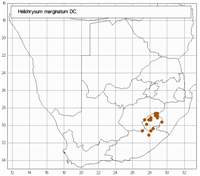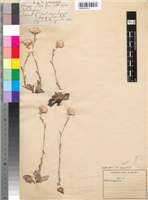Origin of name:
marginatus/ -a/ -um = edge or border referring to the white leaf margins
Diagnostic characters:
RosettesLarge solitary headsWhite bractsHairy leaf margins
Description:
Mat-forming dwarf shrub, main stems prostrate, branching, thick (10 mm diam.) and woody with age, producing many crowded leaf rosettes, flowering stems terminal, often solitary, erect, up to c. 150 mm tall, loosely greyish-white woolly, leafy. Radical leaves lingulate, up to c. 40 x 10 mm, leathery, glandular punctate, glabrous at maturity or occasionally glandular-pubescent, margins white-woolly; cauline leaves similar but smaller and decreasing in size upwards. Heads heterogamous, campanulate, c. 15�20 mm long, double that across the radiating bracts, solitary. Involucral bracts in c. 10 series, graded, loosely imbricate, much exceeding the flowers, acute, snow-white, crimson blotch near base inside. Receptacle scarcely honeycombed. Flowers 195�259, 18�29 female, 175�234 homogamous. Achenes 1.25 mm long, cylindric, with duplex hairs. Pappus bristles many, scabridulous, bases not cohering.
Flowering between December and February.
Distribution:
Forms mats up to a meter across on steep stony mountain slopes and rock sheets. On the high Lesotho mountains and the high Drakensberg from Oxbow and Mont aux Sources south to the Cape Drakensberg and nearby Witteberg, between 2 440 and 3 300 m.
Grassland and Savanna Biomes.
Notes:
Can be confused with H. bellum but distinguished by its different habit, leathery glandular-punctate leaves and hairy achenes.
Taxonomy:
Literature:
Helichrysum marginatum DC., Prodr. 6: 180 (1838); Harv. in F. C. 3: 229 (1865); Moeser in Bot. Jb. 44: 335 (1910); Hilliard, Compositae in Natal 234 (1977).
Type:
Cape, Wittebergen, Dr�ge 3741 (G-DC, holo.; BM; E; K; P; S; SAM; TCD, iso.).
Synonym(s):
Gnaphalium marginatum (DC.) Sch. Bip. in Bot. Ztg 3:170 (1845).
Vouchers:
Hilliard 4993 (E; K; NH; NU); Nordenstam 2089 (LD; NU); Wright 397 (E; NH; NU).

